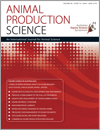
Animal Production Science
Volume 60 Number 18 2020
Equine Science in Australasia
ANv60n18_FOEquine Science in Australasia: past, present and future
AN17685Equine musculoskeletal development and performance: impact of the production system and early training
In contrast to some public perceptions, the horse has evolved to have a musculoskeletal system that responds positively to an exercise challenge at an early stage in its life. This review examines the literature from epidemiological studies through to controlled intervention trials that demonstrate a positive capability of the horse to respond to exercise.
AN17685 Abstract | AN17685 Full Text | AN17685PDF (995 KB) Open Access Article
AN20010Prenatal establishment of the foal gut microbiota: a critique of the in utero colonisation hypothesis
Our understanding of human and animal microbiota has increased significantly and provides insights into how microbes affect health and behaviour from the very start of life. Although the womb was previously considered to be a germ-free environment, bacteria have been found in the fluids surrounding the healthy fetus. The present review discusses the in utero colonisation hypothesis or how bacteria may be transferred from the mare to the fetus during pregnancy and their likely role in kick-starting the gut health of the newborn foal.
AN20010 Abstract | AN20010 Full Text | AN20010PDF (1.3 MB) Open Access Article
AN19629Growth and development of thoroughbred horses
This article contains a review of research into Thoroughbred growth and development. It considers different stages of growth, factors that influence growth and influences on performance in the sales ring and on the racetrack.
AN19386Equine metabolic syndrome: evolution of understanding over two decades: a personal perspective
Equine metabolic syndrome (EMS) is perhaps one of the most recognised clinical conditions by horse owners today due to its association with obesity and, perhaps most importantly, its link with laminitis risk. However, over the past few decades as our knowledge has increased, our understanding of what EMS is has obviously evolved and developed. While not intended to be a comprehensive review of the topic or the literature, the present article provides a short perspective of how the term EMS developed and how its definition has changed over the years, as well as what this might mean to the horse and/or pony owner and their veterinarian.
AN19491A review of recent developments in the pharmacological prevention and treatment of endocrinopathic laminitis
The management of endocrinopathic laminitis is moving towards a multi-faceted approach. While effective dietary management and exercise will remain essential, the inclusion of drugs that address foot pathology, pain and underlying endocrine disturbances will become more common.
AN19491 Abstract | AN19491 Full Text | AN19491PDF (270 KB) Open Access Article
AN18698The dynamics of energy supply and demand of foaling mares managed at pasture: a deterministic modelling approach
Information on the nutritional status of mares is needed for sound nutritional management and efficient pasture utilisation on Thoroughbred stud farms. Mares managed on pasture may enter energy deficit during lactation that can lead to body condition loss, and impact reproductive performance. The size of the deficit is driven by the dynamic associations between energy supply from pasture and the timing of increased lactation requirements. There is a need for the monitoring of pasture quality and supply, feed budgeting and active stock management on stud farms especially during the breeding season.
Little is known about the prevalence of important horse worm species on Australian farms or how horse owners manage them. Our study showed a high farm prevalence of cyathostomin and roundworms (Parascaris equorum), a much lower presence of tapeworm and large strongyles (Strongylus vulgaris) and a reliance on worm-control practices that may encourage drug resistance. These results can help inform more strategic and sustainable worm-management regimens into the future.
AN16728Commercial equine production in New Zealand. 1. Reproduction and breeding
Breeding mares are kept at pasture in New Zealand and reproductive efficiency is improving. However, Thoroughbred breeders face significant pressures from industry with a short breeding season that does not match the timing of the natural breeding season, and popular stallions are required to breed many mares. Breeding horses require excellent stud management and veterinary management to achieve industry targets.
AN16752Commercial equine production in New Zealand. 2. Growth and development of the equine athlete
The utilisation of pasture as a predominant source of nutrition for broodmares and young stock is a unique feature of the New Zealand commercial equine industry. The export focus of the Thoroughbred industry has a large influence on many husbandry practices and industry structure.
AN16753Commercial equine production in New Zealand. 3. The racing and sport industries
This review presents data on the size, scope and organisation of equestrian sport and racing within New Zealand. The keys features of which are shaped by pasture-based management and a large export focus for the Thoroughbred industry. Describing the racing and sport-horse industries is essential to aid understanding of the production process of the equine athlete in New Zealand.




